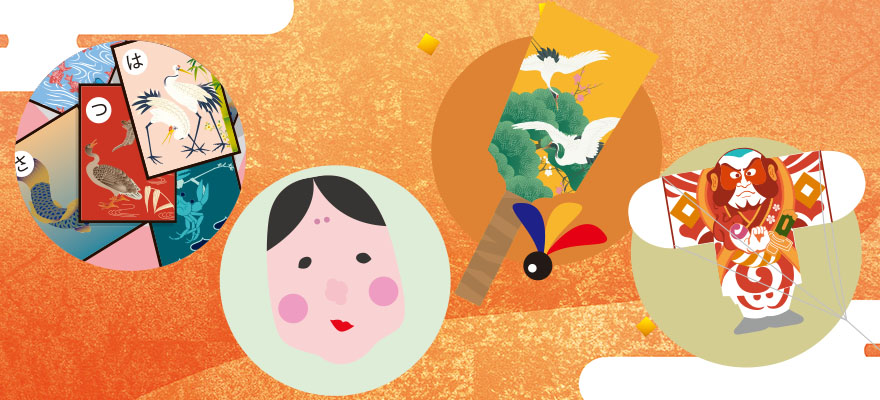Home > Highlighting JAPAN >Highlighting Japan January 2014>Student's Corner
Highlighting JAPAN
Student's Corner
Ganjitsu no Asobi

New Year's Day is one of Japan's most important holidays. It's a time spent with family, and many people go back to their hometowns to visit parents, grandparents and cousins during the New Year's period. It's also an ideal time to lounge around the house eating, playing games and laughing with family.
While nowadays people are most likely to watch TV and play video games over the holidays, there are a variety of games that have been traditionally played at New Year's in Japan:
Karuta
Karuta is a matching game played with beautifully illustrated cards. There are many variants of the game, but the most famous is called Hyakunin Isshu, or 'Poems from One Hundred People.' Most of these poems were written in the Heian period, about a thousand years ago. A caller reads the first three lines of a poem from a 'reading card,' or yomifuda. As he or she reads, the other players race to find the last two lines among the torifuda, or 'grabbing cards,' laid out on the table:
If I see that bridge–
The caller recites in a sing-song voice. The players gathered around the table peer at the cards in concentration.
That is spanned by flights of magpies–
One player's hand shoots out just as the caller recites the third line!
Across the arc of heaven–
The player slaps the card with the last two lines of the poem:
Made white with a deep-laid frost,
Then the night is almost past.
The caller confirms this is the right card. If it is, the player gets to keep the card while the caller goes on to the next poem. When the game ends, the player with the most cards is the winner.
(Poem by Ōtomo no Yakamochi)
Fukuwarai
Have you ever played Pin the Tail on the Donkey? The game fukuwarai ('lucky laugh') is very similar. First, the players cut out a big paper circle to make a face. From a separate sheet they cut out eyes, a nose, a mouth and sometimes even cheeks and eyebrows, too. One player is blindfolded, and he or she tries to place all the features on the face. The other players can shout instructions, but there's no peeking! The player then takes off the blindfold to see the silly face he or she made.
Hanetsuki
Moving outside, another common New Year's pastime is hanetsuki. This is a game very much like badminton, but it's played with wooden paddles instead of stringed rackets. The paddles are painted in lively colors with kabuki actors or familiar characters, and the feathered shuttles may be brightly dyed, too. To play, you have to bat the birdie back and forth with the paddle, trying to keep it in the air as long as you can. Don't let it drop! The loser has to mark his or her face with a dab of ink, so if you play for a while you may get very messy.
Takoage
Another outdoor New Year's activity is takoage, or kite flying. These kites are traditionally made from bamboo and paper, though they're sometimes made of cloth and wood as well. The shape of the kite, and the pictures on it, will vary by region, but some popular examples are yakko, takarabune and eto:
Yakko kites are shaped with stubby arms and legs, and are usually painted to look like samurai, dragons or ogres. They often look quite fierce!
Takarabune means 'treasure ship.' This image is lucky for the coming year.
Eto refers to the 12 horary signs of the Chinese zodiac. This kite is painted with the year's zodiac animal. For example, 2014 is the year of the horse.
When you're running in the cold air holding the string, and your kite starts to lift in the wind, you can feel your heart lift at the same time. What a great way to start the New Year!
© 2009 Cabinet Office, Government of Japan






